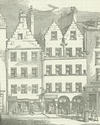 Most people did their shopping at the stalls set up on market days near the mercat cross, with luxuries and treats bought from travelling hawkers and pedlars or during the Glasgow Fair. By the 1830s Candleriggs had a permanent bazaar selling vegetables, eggs, poultry, cheese and butter. Fixed shops were still quite rare in the 1770s but were growing in number aimed at the increasingly prosperous middle ranks. Little attention was paid to display and most shops were little more than rooms in tenements. But as population grew so did the number of shops. Then as now, similar shops tended to cluster. The south side of the Trongate, the main shopping area, had a range of shoe shops, while across the street convenient for the College were a number of booksellers, such as Brash & Reid's and Robert McPhun's. For cutlery and hardware people would head for the Saltmarket, for hosiery, to the east side of the High street. New Street, soon to become King Street, had a cluster of grocery and provision shops.
Most people did their shopping at the stalls set up on market days near the mercat cross, with luxuries and treats bought from travelling hawkers and pedlars or during the Glasgow Fair. By the 1830s Candleriggs had a permanent bazaar selling vegetables, eggs, poultry, cheese and butter. Fixed shops were still quite rare in the 1770s but were growing in number aimed at the increasingly prosperous middle ranks. Little attention was paid to display and most shops were little more than rooms in tenements. But as population grew so did the number of shops. Then as now, similar shops tended to cluster. The south side of the Trongate, the main shopping area, had a range of shoe shops, while across the street convenient for the College were a number of booksellers, such as Brash & Reid's and Robert McPhun's. For cutlery and hardware people would head for the Saltmarket, for hosiery, to the east side of the High street. New Street, soon to become King Street, had a cluster of grocery and provision shops.
 The main concentrations of shops of all kinds were in the Gallowgate and the Trongate: more than 250 in the former and 230 in the latter in 1819. But as the city spread westwards, so did the shops along Argyle Street. Robertson Stewart & John MacDonald with their drapery warehouse ventured round the corner into the relatively new Buchanan Street in 1826 just in time to take advantage of Scotland's first shopping arcade linking Argyle Street and Buchanan Street. By the end of the 1830s Buchanan Street was emerging as the shopping street for the well-to-do.
The main concentrations of shops of all kinds were in the Gallowgate and the Trongate: more than 250 in the former and 230 in the latter in 1819. But as the city spread westwards, so did the shops along Argyle Street. Robertson Stewart & John MacDonald with their drapery warehouse ventured round the corner into the relatively new Buchanan Street in 1826 just in time to take advantage of Scotland's first shopping arcade linking Argyle Street and Buchanan Street. By the end of the 1830s Buchanan Street was emerging as the shopping street for the well-to-do.